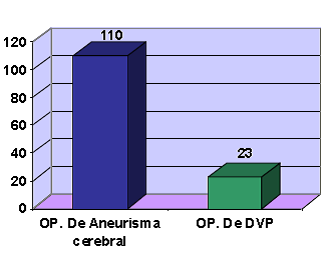Usted está aquí
Peruvian Journal of Neurosurgery
Clinical and Epidemiological Characteristics of Patients with Hydrocephalus Secondary to Subarachnoid Hemorrhage Hospitalized in the Neurosurgery Department of Rebagliati Hospital 2007-2008
ABSTRACT
Objective: The aim of this study is to know the clinical and epidemiological characteristic of patients with hydrocephalus secondary to subarachnoid hemorrhage during the period April 2007-2008. There is no a complete knowledge about this pathology in our country.
Patients and Methods: We reviewed medical records of 110 patients who underwent surgical clipping of cerebral aneurysm. Of these we selected those who developed hydrocephalus secondary to subarachnoid hemorrhage and placed ventricle-peritoneal shunts corresponding to 23 patients .
Results: It was found that the hydrocephalus secondary to subarachnoid hemorrhage with a 43% of cases. It was found that the hydrocephalus secondary to subarachnoid hemorrhage occurred in 21% and most often from first to second month of the event of a subarachnoid hemorrhage with a 43 % of cases . Besides is more frequent in women over 50 years and disturbance of consciousness is the main clinical sintomatolgy . These findings are consistent with Anglo-Saxon literature available.
Conclusion: Surely a judicious indication of a VPS greatly influences the patient's recovery. However, it should be noted that the recovery of patients with subarachnoid hemorrhage is multifactorial.



